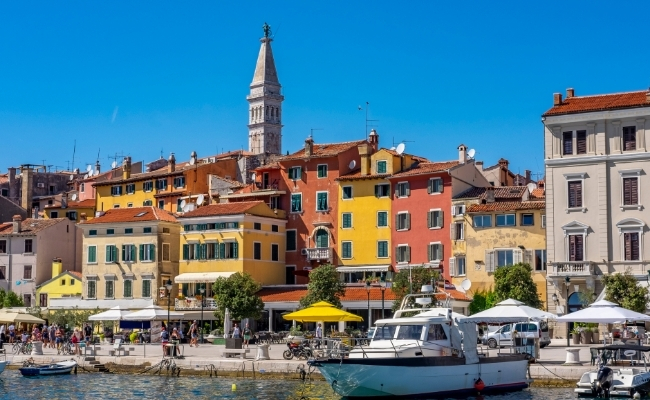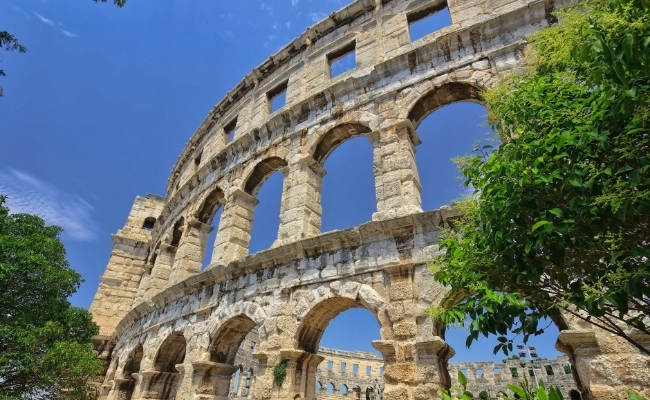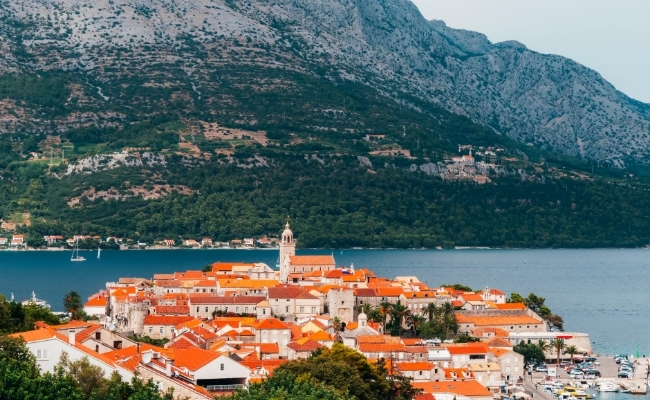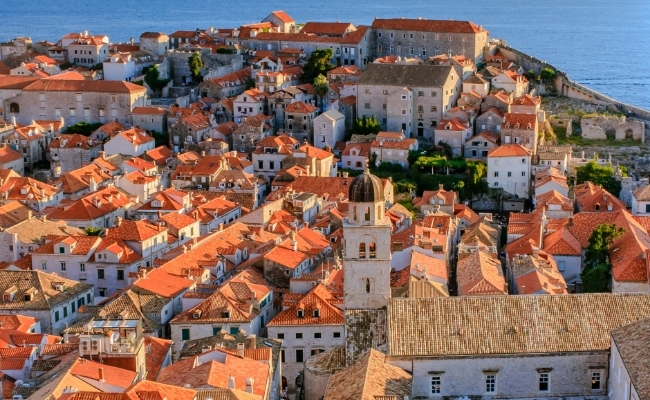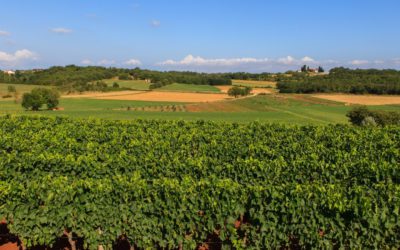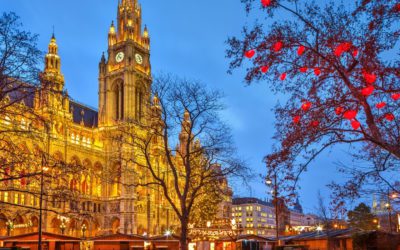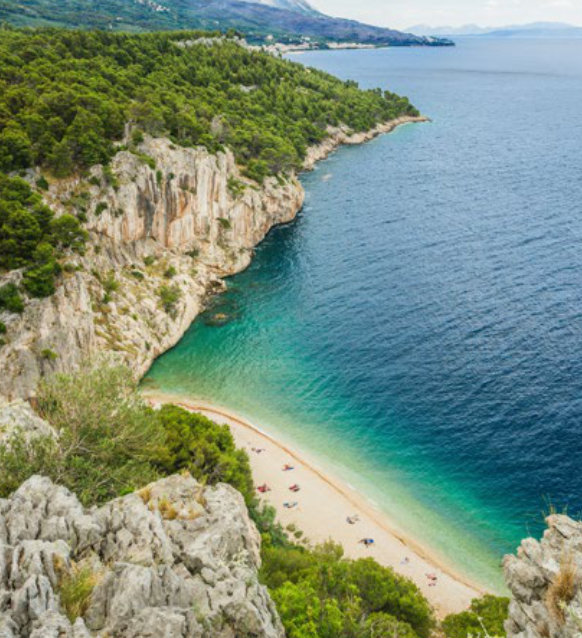Explore Northern Croatia and Dalmatia
Croatia Tours (private journeys) | Food & Wine | Privately Escorted
11 Day Custom Itinerary, Private Journey from north to south
Visiting: ROVINJ – PULA – LOŠINJ ISLAND – MALI LOŠINJ – SPLIT – KORČULA – ELAPHITI ISLANDS – DUBROVNIK
Highlights
Itinerary
Day 1: VENICE AIRPORT – TRIESTE - POREC - ROVINJ

Trieste is a city and seaport in northeastern Italy. It is situated towards the end of a narrow strip of Italian territory lying between the Adriatic Sea and Slovenia, which lies almost immediately south and east of the city. Trieste is located at the head of the Gulf of Trieste and throughout history, it has been influenced by its location at the crossroads of Germanic, Latin, and Slavic cultures. Trieste was one of the oldest parts of the Habsburg Monarchy. In the 19th century, it was the most important part of one of the Great Powers of Europe. As a prosperous seaport in the Mediterranean region, Trieste became the fourth largest city of the Austro-Hungarian Empire (after Vienna, Budapest, and Prague). In the fin-de-siecle period, it emerged as an important hub for literature and music. However, the collapse of the Austro-Hungarian Empire and Trieste’s union to Italy after World War I led to some decline of its “Mittel-European” cultural and commercial importance. Enjoying an economic revival during the 1930s and throughout the Cold War, Trieste was an important spot in the struggle between the Eastern and Western blocs. Today, the city is in one of the richest regions of Italy and has been a great center for shipping, through its port (Port of Trieste), shipbuilding, and financial services. Poreč is a town and municipality on the western coast of the Istrian peninsula, in Istria County, Croatia. Its major landmark is the 6th-century Euphrasian Basilica, a UNESCO World Heritage Site since 1997. Poreč is almost 2,000 years old and is set around a harbor protected from the sea by the small island of Saint Nicholas/San Nicolo (St. Nicholas). Ever since the 1970s, the coast of Poreč has been the most visited tourist destination in Croatia. The town plan still shows the ancient Roman Castrum structure. The main streets are Decumanus and Cardo Maximus, still preserved in their original forms. Marafor is a Roman square with two temples attached. One of them, erected in the first century AD, is dedicated to the Roman god Neptune. Poreč’s heritage can be seen in the historic town center, in museums and galleries hosted in houses and palaces, many of them still private homes as they have been for centuries.

Rovinj is the most romantic place in the Mediterranean! The town of Rovinj is the right destination if you are seeking a sentimental atmosphere of the times that have forever gone by. Rovinj has begun its romantic life on an island, its restricted area resulting in crowded houses, narrow streets, and small squares, still untouched by modern urbanism. Built upon a rich fishermen’s tradition, it has become distinctive for its unique boat called batana and its songs bitinada. Its beauty was particularly appreciated by artists who have painted the most beautiful motifs here and exhibited them on Grisia, the street of artists.
Itinerary
- Arrival to Venice Airport and a private transfer to Rovinj
- Time at leisure and an overnight at your hotel Private transfer from Venice Airport to Rovinj in a modern, air-conditioned car with optional stops
- Accommodation in 5* Hotel in Rovinj, BB basis
Day 2: ROVINJ

The old town of Rovinj is the protected historical center of Rovinj with a Town Hall building and a large square lined with renaissance houses from the 16th century, the most appealing part of the town for visitors. The narrow cobbled alleyways and the small squares which have witnessed the turbulent history of the town are full of medieval, gothic, renaissance, and baroque buildings and terraces. On the northern side, you will find the remains of the walls that used to protect the town’s inhabitants from conquerors and looters as well as Balbi’s Arch from 1679. Walking down the old alleys is a very special experience – you will feel like time has stopped and you have returned to the ancient era. Walking in the historic old town, you will find a new surprise at every step. St Euphemia Parish Church, the symbol of the town of Rovinj, other small churches, monuments, old doors, and arches await behind every corner, and if you find yourself in need of a break and rest, your kind hosts will invite you into one of the numerous restaurants.
Visit the old town of Rovinj, the keeper of history and heritage of one of the most photogenic Mediterranean towns walk Bregovita and Švalbina streets, lined with baroque buildings or the Grisia Street where Rovinj artists exhibit their pieces with a personal approach and talk to visitors.
Itinerary
- Breakfast at the hotel and time to explore the town on your own
- Overnight in Rovinj Accommodation in 5* Hotel in Rovinj, BB basis
Day 3: ROVINJ

Sometimes called the “Lim Fjord”, “Limski Bay”, “Limski Kanal” or “Limska Draga”, this 9km-long sea inlet cuts into the west coast of Istria between Rovinj and Porec. No matter the name, this drowned valley is one of Istria’s most stunning features. The walls of the drowned valley become steeper as the water curves inland, reaching a height of 100m. No development marks the macchia-covered hillsides and the clean, calm water is a shimmering blue. The area around the channel has been inhabited since the Neolithic era. These early settlers burrowed into caves along the valley which have been excavated to reveal remnants of their former occupants. Ancient Illyrians then moved in and settled around the hill fort of Gradina. Under the Romans, the channel formed the border between the administrative units of Porec and Pula. The name lim is derived from the Latin limes, meaning border. According to legend, St Romuald, the founder of a nearby monastery inhabited one of the ancient caves for several years in the 11th century. The 105m-long St Romuald’s cave is open for visits in the summer. Fishing in the Lim Channel has always been excellent. Now the natural species have been augmented by farmed mussels and oysters which are on offer in two excellent restaurants on the channel.
Itinerary
- Breakfast at the hotel and morning at leisure
- Choose the most elegant way to spend your day and explore the beautiful Istrian coast and its picturesque bays with a private motor yacht. Spend your day with your skipper exploring Brijuni, selected islands, and beaches for a relaxed day on the sea.
- Half-day cruise to Lim channel
- Return to the hotel and time at leisure
- Overnight in Rovinj Half-day cruise to Lim channel on Punta yacht (the price includes: yacht with skipper service, fuel, insurance, light snack and refreshments, linens, and towels)
- Accommodation in 5* Hotel in Rovinj, BB basis
Day 4: ROVINJ – PULA – LOŠINJ ISLAND

Pula is the largest town on the Istrian peninsula and offers a diversity of attractions to lovers of culture. The rich itinerary of its three-thousand-year-old history, where every step you take through the old town is a landmark, begins and ends with the Roman amphitheater. While strolling through Pula you will come across numerous monuments of Roman architecture: the Triumphal Arch of the Sergi from the 1st century B.C., Hercules’ Gate and Twin Gates, the Temple of Augustus, Arena and Small Roman Theater in the town center. A unique experience will be moments of relaxation in the main town square, which has managed to retain its role as the meeting place since the Augustan Age. Where you breathe with your full lungs, where waves of Istria, Kvarner, and Dalmatia intertwine, and where the last North Adriatic school of dolphins swim happily – that’s where the Lošinj Archipelago is located. This is a magical place that will seduce you with all its attributes – scents, tastes, sounds, and preserved natural beauties.

Lošinj has a health tourism tradition of over 125 years. Thanks to its mild Mediterranean climate, pinewoods, and air, this is an ideal place to recreate your body and spirit.

Mali Lošinj is the biggest settlement on the island of Lošinj, found on the southern side of the Bay of Lošinj, which, thanks to this position, has become a very important maritime and commercial center, and today, also an important tourist destination. Positioned in August Bay, the biggest closed bay of the island, and with 7000 inhabitants, today it is the biggest island town in the Adriatic. Mali Lošinj dates back to the 12th century when twelve Croatian families settled in the eastern bay of St. Martin. First Croatian settlers were farmers, later they also turned to fishing, sailing, and shipbuilding, and with that, the settlements moved toward the coast.
Itinerary
- Breakfast at the hotel and check out
- Private transfer from Rovinj to Pula
- Seaplane transfer from Pula Downtown to Mali Lošinj Airport (subject to availability)
- Private transfer to your hotel, time at leisure, and overnight in Lošinj Private transfer from Rovinj to Pula in a modern, air-conditioned car
- Seaplane transfer from Pula Downtown to Mali Lošinj Airport (subject to availability)
- Private transfer from Mali Lošinj Airport to your hotel in a modern, air-conditioned car
- Accommodation in 5* Hotel in Mali Lošinj, BB basis
Day 5: MALI LOŠINJ
The golden age for Mali Lošinj was the end of the 19th century when thanks to seafaring the “small village” turned into a maritime town. Because of the big changes and the maritime crisis in the region, due to the passing of sailboats to steamboats, it seemed that the destiny of this, and similar towns, was sealed. Upon discovering the health benefits of the climate, and growing of the new economic realm, tourism, a new page in the island’s history was open. There are only seven surviving statues of the ancient Greek athlete Apoxyomenos in the world, one of which was found right here in Croatia. More than two thousand years old ancient bronze statue of an unknown author was found in 1999 in the sea near the island of Lošinj, wedged between two rocks at a depth of 45 meters. Over a two-thousand-year-old athlete was lifted from the depths of the sea and after almost seven years of restoration returned to its former glory.

The statue represents an athlete, a young sportsman at the moment of cleaning oil, dust, and sweat from his body with a scraping tool, after a competition. During the restoration, which lasted almost seven years, while researching the material and style of workmanship, it was determined that the statue dates from 2nd-1st century BC, while the prototype which it was based on is considerably older, from the middle of the 4th century BC. From the eight known variations of the Apoxyomenos prototype, the Lošinj statue is the most complete and best-preserved. The statue of Apoxyomenos, which was extracted from Lošinj`s seabed on 27 April 1999 will be permanently exhibited in Mali Lošinj, at the Kvarner Palace from 2016. Apoxyomenos is not the only gem in Losinj’s cultural heritage. Austro-Hungarian villas and captain’s houses, monasteries, a fort, a basilica, ancient remains, museums, churches, and chapels are all to be found. Visit the Town Museum in the Fritzy Palace, or the chapel Annunziata in Cikat Bay and learn more about the island’s rich maritime history, its glorious captains, and their fleets. Mali Losinj is also known for its gastronomic delicacies, as well as a plethora of classic music, sporting, and cultural events.
Itinerary
- Breakfast at the hotel and time to explore the island on your own
- Privately guided half-day trip to Susak Island on a motor yacht for possible Dolphin sighting.
- Overnight in Lošinj
- Accommodation in 5* Hotel in Mali Lošinj, BB basis
Day 6: MALI LOŠINJ
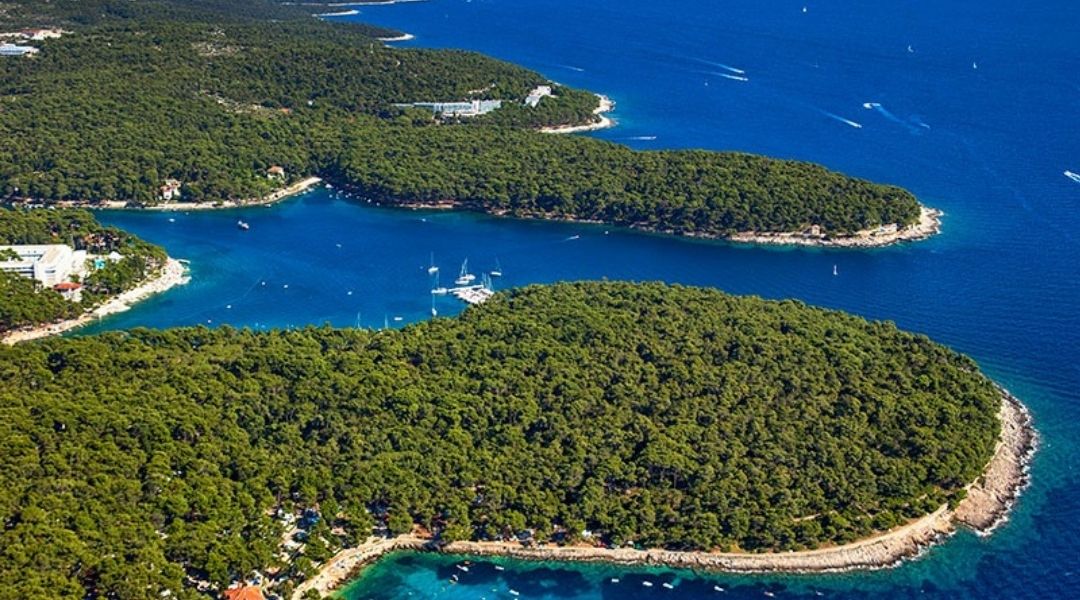
Čikat forest park is a man-made ecosystem that has resulted from deliberate efforts to shape the landscape and act in harmony with nature. Several attractive marked walking paths pass through the forest park. The origins of Čikat forest park date back to the year 1886 when the Society for Afforestation and Embellishment of Mali Lošinj was established. The lush forest of Aleppo pine was planted on barren land at the end of the 19th century as a result of the endeavors of the Society for Afforestation and Embellishment of Mali Lošinj under the guidance of Ambroz Haračić, a renowned naturalist, and patriot from Lošinj. The promontory of Anuncijata hosts the church of the Blessed Virgin Mary which was built in 1858. This is the traditional votive church of Lošinj’s seafarers. The Lošinj Aromatic Garden is a nursery of the island medicinal herbs in Mali Lošinj. Enjoy the fragrance and perfumes of scented gardens and confirm the eternal tale about Lošinj – a place renowned for cherishing a healthy life and unharmed nature.
Itinerary
- Breakfast at the hotel and time to explore the island on your own
- Overnight in Lošinj
- Accommodation in 5* Hotel in Mali Lošinj, BB basis
Day 7: MALI LOŠINJ – SPLIT – KORČULA
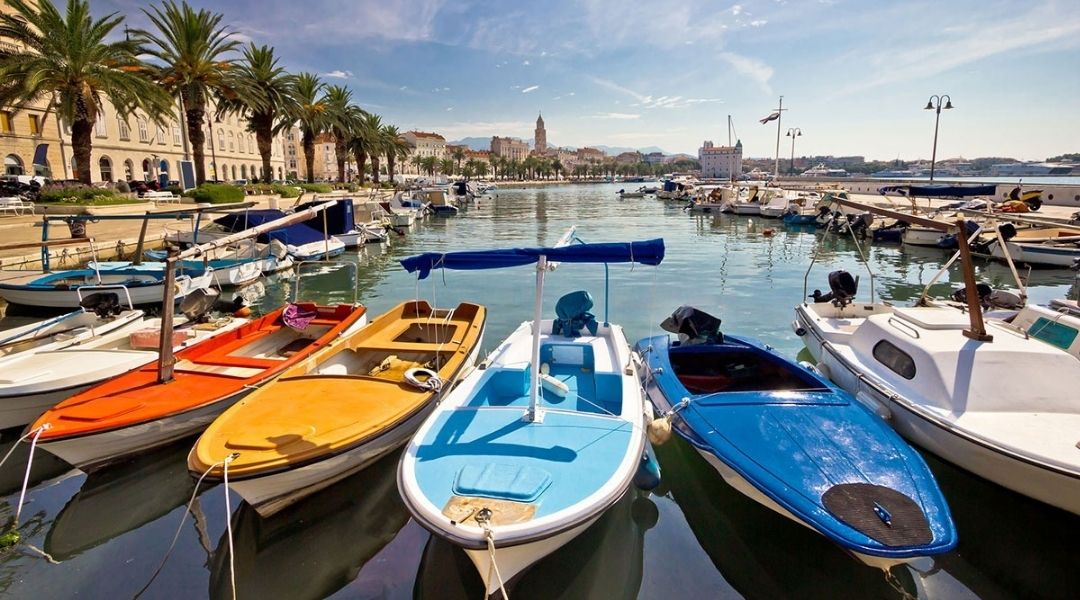
Olives, indigenous aromatic plants, the brilliancy of white stone against the verdant vegetation and the towering mountain massif of Biokovo whose spurs reach all the way to the sea – yes, this is indeed an exceptional part of the country, and its beauty is made all the more enchanting by numerous historic events and monuments, and cultural manifestations. When, in the year 305, the Roman Emperor Diocletian, who ruled the entire world at that time, decided to build his leisure time abode – in which he intended to spend the rest of his life – he had no doubt as to exactly where build to it. In the very heart of Dalmatia, in the bay of Aspalathos (Split), well protected from the sea by the islands of the Split archipelago, and defended on its landward side by high mountains, Diocletian created a special point on the map of the Adriatic: the future city of Split.

The Riva, a marble-white and palm-lined connection of Split and the Adriatic is everyone’s favorite spot for socializing, coffee drinking, or just idle sitting on one of the comfy benches which face the sea. Riva is full of life throughout the day, especially during the summer, and you’ll always find people strolling along or sitting in one of the cafes. So, if you want to get a feeling of the local everyday “buzz” be sure to grab your spot and you’ll soon experience firsthand how important and irresistible is the coffee culture in Croatia.

There’s no doubt Diocletian’s Palace is the top must-see attraction in Croatia’s second-biggest city –Split. This UNESCO-protected World Heritage Site is actually the heart of the whole city – almost two thousand years old, the enormous palace exists today as a “living monument” – meaning it’s dotted with quaint shops, galleries, cafes, restaurants, and people actually live and work within its old walls. And that’s what makes it really special – it’s an ancient Roman palace absolutely integrated into the everyday life and doings of Split and its people.
Itinerary
- Breakfast at the hotel and check out
- Private transfer from your hotel to Mali Lošinj Airport
- Seaplane transfer from Mali Lošinj Airport to Split (subject to availability)
- Arrival to Split and time at leisure
- Seaplane transfer from Split to Korčula (Lumbarda) – (subject to availability)
- Private transfer to your hotel, time at leisure, and overnight in Korčula
- Accommodation in 5* Hotel on Korcula, BB basis
Day 8: KORČULA

Korčula was first mentioned as early as the 10th c. in works of Byzantine historians under the name “Stone Town”. It flourished under the Venetian government and later on it spread around the town walls. But in spite of all that, it is still the most famous as the birthplace of Marco Polo who was probably born here in 1254, and reminders of him can be seen all around the town, including the extremely interesting Marco Polo Museum which is something you definitively don’t want to miss when visiting this beautiful Dalmatian town. Today it`s a town where you can vividly feel the Mediterranean spirit of people who live and work in this mixture of Gothic, Renaissance, and Baroque architecture. Korčula Town is famous for the Moreška, a traditional sword dance once common throughout the Mediterranean. It’s now a major tourist attraction, and its annual performance on St Theodore’s Day (July 29) has been transformed into a regular show, held every Monday and Thursday evening between May and September at the open-air cinema beside the Land Gate. The dance probably originated in Spain and related to the conflict between the Moors (hence the name) and the Christians, although in Dalmatia its popularity was connected with the struggles against the Ottomans. Basically, the dance tells the story of a conflict between the White King and his followers (actually dressed in red) and the Black King. The heroine, Bula, is kidnapped by the Black King, and her betrothed tries to win her back in a ritualized sword fight. The adversaries circle each other and clash weapons several times before the evil king is forced to surrender, and Bula is unchained. The strangest thing about the dance is the seemingly incongruous brass-band music that invariably accompanies it – a sign that the present-day Moreška falls somewhere between ancient rite and nineteenth-century reinvention. Similar sword dances are still performed throughout the island, although they are more archaic in form and frequently accompanied by traditional instruments such as the mijeh (bagpipe).
Itinerary
- Breakfast at the hotel and time to explore the town on your own.
- Overnight in Korčula
- Accommodation in 5* Hotel on Korcula, BB basis
Day 9: KORČULA – ELAPHITI ISLANDS – DUBROVNIK

Escape the hectic city of Dubrovnik and explore three magnificent islands that together form the Elaphite Islands. Lopud, Sipan, and Kolocep are unique and each contains beauty and history of their own. These islands attract a great number of tourists due to their close proximity to Dubrovnik and aesthetic charm. It is possible to visit them as a half-day or full-day private excursion from Dubrovnik. Enjoy visiting these islands, with a speedboat or yacht as well as having the opportunity to explore hidden bays and sea caves, or go water tubing, snorkeling or fishing along the way. Surrounded by enchanting reefs, Kolocep is the first island visited on this journey. Relax, bask in the sun and take a refreshing swim while visiting Kolocep’s sea cave, before continuing to the famous island of Lopud. The most popular and populated of the three islands, Lopud, is known for its sandy beach, Sunj, where there is time for swimming and snorkeling. However, it also contains a pine and cypress park, historical monuments, and medieval architecture that are worth exploring as well. Time for lunch is available at a local restaurant on any of the islands with an authentic ambiance and domestic seafood specialties. Sipan is the last of the Elaphite Islands. Visit the old port in Sudjuradj and its Skocibuha castle, followed by a visit to small villages on both Lopud and Kolocep when circling around on the way back to Dubrovnik. The sheer geographical position of the Elaphite islands offers guests the perfect opportunity to island-hop. These untouched islands are a wonder of nature and also provide an experience of true island life, Dalmatian style. Situated to the northwest of Dubrovnik this group of islands is made up of eight islands, the majority of which are uninhabited, and with this full-day excursion, you will have the opportunity to visit three of them – Koločep, Šipan, and Lopud. Take a dip in the crystal clear seas, stroll in the shade of Mediterranean vegetation, explore quaint hamlets or simply indulge your taste buds with local cuisines, the choice is yours. Kolocep Island is the closest to Dubrovnik. On the island, there are two villages – Upper and Lower Forehead. Unlike most other islands in the Adriatic, Koločep is rich with fertile soil and water and is full of lush vegetation. Since ancient times Koločep is known as an island of fishermen and coral, and today is the fishery area, especially rich in lobsters.

Lopud Island is located northwest of Dubrovnik. It is the second largest of the Elaphiti islands and is located between Sipan and Koloče. In the Middle Ages, it was named the Insula media ‘(Latin for Middle Island). Lopud Island is the most developed Elaphiti. Popular sandy beach Šunj is often the destination of hikers and swimmers. At each step at the island, various medieval fortresses and chapels merge, which illustrate the history of this island. Lopud island is peaceful and is suitable for holidays in silence among the cypress trees, palm trees. Island Sipan is the largest island in the group Elaphiti archipelago. It was inhabited in prehistoric times. The interior of the island spread karst fields which, opening up to the east and west, create deep bays. On the shores of West Bay lies village Luka Šipanska, while on the eastern shores of the bay has developed a village called Suđurad. On the island of Sipan is a lot of private houses with apartments built in the style typical of this area.

Dubrovnik is a medieval city on the Croatian side of the Adriatic coastline and treasure trove of cultural, historical monuments that were created throughout its thousand-year existence. In the past, it was a City-Republic, and alongside Venice one of the most famous cultural-economic centers on the Mediterranean. In more recent times, it has become the center of modern cultural and tourist events: a city of summer festivals – an international parade of top musical and theatrical achievements, a city of museums and galleries. These values have turned Dubrovnik into a place that offers a rich selection of various experiences and excitement, but also a complete holiday in a quiet and calming, mild Mediterranean ambiance and wonderful seaside landscapes.
Itinerary
- Breakfast at the hotel and check out
- Private transfer from Korčula to Dubrovnik on a motor yacht with a cruise around the Elaphiti islands and occasional stops for a walk or a swim. Perfect for anyone looking to enjoy the fresh air and bask in the sun rather than in a car, this route to Dubrovnik is a pleasant alternative for a private excursion with a beautiful speedboat or yacht from Korčula. Cruise through 50 nautical miles towards Dubrovnik (2 hours – direct one way) while enjoying the ravishing scenery of surrounding islands, away from Dubrovnik’s traffic jams, buses, and busy streets.
- Optional lunch stop at Koločep island
- Transportation to/from the Boarding Location
- Arrival in Dubrovnik, time at leisure, and overnight
- Accommodation in 5* Hotel in Dubrovnik, BB basis
Day 10: DUBROVNIK

Stradun – the main street of Dubrovnik where everyone’s walked and also the busiest street where you stroll over marble tiles. Stradun is a great place for everyone for shopping, with cafes, restaurants, and streets filled with many wonderful shops. Onofrio’s Fountain – this drinking fountain is located just at the beginning of Stradun, the main street of the old town. The structure was named after its builder, the Italian Onofrio de la Cava, which dates from 1440 and includes 16 sides. The concept is part of the water supply system of the city and brings water from the well in Rijeka Dubrovacka, more than 20 km away, to the heart of the city. Before that this interest was, therefore, more than a masterpiece of architectural sophistication. Originally the fountain was decorated with a sculpture, which was destroyed in the earthquake of 1667, the Remaining 16 stone masks from which the water flows into a lake.

The Clock Tower was built in the 15th Century right at the other end of the Placa (the main thoroughfare) and represented alongside nearby buildings a free city-state. The tower is approximately 31 meters in height and was built by Grubacevic, Utisenovic, and Radoncic, local masters. Following an earthquake, the structure of the Clock Tower lost its structure and leaned. In order for it not to fall the Clock Tower was rebuilt in 1929. Orlando’s column was built in 1418, then it was the focal point of the city and Government ordinances and punishment carried out. A flag flies above the statue with the ‘Libertas’ motto. The medieval cult of Orlando (Roland) started here in the 12th century based on the epic poem ‘Song of Roland’
Itinerary
- Breakfast at the hotel and time to explore the city on your own
- Time at leisure and an overnight in Dubrovnik
- Accommodation in 5* Hotel in Dubrovnik, BB basis
Day 11: DUBROVNIK
 Itinerary
Itinerary
- Breakfast at the hotel and check out
- Private transfer from your hotel to Dubrovnik Airport in a modern, air-conditioned car

This package includes:
- ALL PRIVATE and ENGLISH SPEAKING GUIDES AND DRIVERS
- VAT TAX INCLUDED
- 24hr concierge and in Croatia assistance
- Private transfer from Venice Airport to Rovinj in a modern, air-conditioned car
- 3 nights in 5* Hotel in Rovinj, BB basis
- Half-day cruise to Lim channel (the price includes: yacht with skipper service, fuel, insurance, light snack and refreshments, linens, and towels)
- Private transfer from Rovinj to Pula in a modern, air-conditioned car
- Seaplane transfer from Pula Downtown to Mali Lošinj Airport (subject to availability)
- Private transfer from Mali Lošinj Airport to your hotel in a modern, air-conditioned car
- 3 nights in 5* Hotel in Mali Lošinj, BB basis
- Privately guided half-day trip to Susak Island on a brand new motor yacht for possible Dolphin sighting.
- Private transfer from your hotel to Mali Lošinj Airport
- Seaplane transfer from Mali Lošinj Airport to Split (subject to availability)
- Seaplane transfer from Split to Korčula (subject to availability)
- Private transfer from the seaplane dock to your hotel in Korčula
- 2 nights in 5* Hotel on Korcula, BB Basis
- Private transfer from Korčula to Dubrovnik on a motor yacht with a cruise around the Elaphiti islands (Incl. Personal Skipper /Crew and Boat at Your Full Disposal)
- 2 nights in 5* Hotel in Dubrovnik, BB basis
- Private transfer from your hotel to Dubrovnik Airport in a modern, air-conditioned car

The program does not include:
- Meals and drinks not mentioned above
- Airfare
- Travel Insurance
- Additional excursions and / or services not mentioned in the program
- Personal expenses (internet, telephone, mini bar etc.)
- Tips and porterage services
Dates and Pricing
PRICES FROM
$5,300
PER PERSON
TRAVEL BETWEEN
May – October
AVAILABLE DATES UPON REQUEST
Double Occupancy Cabins
Solo traveler with supplement
